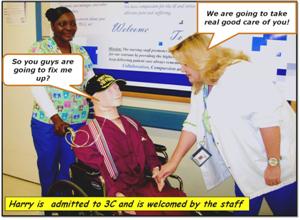Bringing Simulation Back to Life

By Denise R. Cochran Coordinator for Interdisciplinary Simulation Education Center; lead Mock Code Drill Instructor Malcolm Randall VA Medical Center
GAINESVILLE, FL - At first glance, he's just a simple mannequin, made of plastic, foam and paint. However, once he dons his Vietnam Veteran ball cap, VA pajamas, as well as red-white-and-blue suspenders, he becomes Heart Attack Harry, SuperVet, dying several times a day in order to help bring life to others by improving emergency response all around the Malcolm Randall VA Medical Center.
In this image or panel, "Harry" is admitted to the medical center. Illustrations for a booklet series are in the form of panels designed in the style of a comic book to illustrate a variety of medical training scenarios.
Heart Attack Harry is a vital part of the North Florida/South Georgia (NF/SG) Veterans Health System Interdisciplinary Simulation Education Center (ISEC). Here, medical providers come together to advance their clinical skills, foster critical thinking and nurture interdisciplinary teamwork.
With the mock code drill program, Heart Attack Harry regularly appears on inpatient and outpatient care units and challenges staff to respond to a simulated cardiac arrest scenario. Staff members are expected to call a code blue, initiate CPR and attempt to resuscitate Harry using their crash cart and defibrillators or automatic external defibrillators. Drill performance is rated by a drill instructor using an objective measurement tool to score their response for specific actions needed to be completed within 4 minutes. Participants then evaluate their own performance through a facilitated debriefing session. The drills are designed to give staff an opportunity to practice and apply basic life support and advanced cardiac life support (ACLS) skills and to develop effective teamwork and communications while gaining experience with equipment and supplies commonly used in emergent situations.
Mock code drills have also been instrumental in assessing system processes in differing patient care environments during medical emergencies. Evaluation of code drill performed in patient care environments (in situ) have helped to identify problems and barriers that adversely affect code performance and outcomes. Issues impacted as a result include the availability of needed equipment and supplies, arrangement of furniture in patient care areas and issues of patient transport and communication systems.
For example, results gathered from these training exercises led to the redesign of all the crash carts in the system. Once new design models and system processes were proposed, piloting and testing was completed through simulation code drills. Staff education on the final product was further enhanced through hands-on simulation-based training in patient care areas and in ACLS code training in ISEC.
Evaluation of code drills performed in patient care environments (in situ) have helped to identify problems and barriers that adversely affect code performance and outcomes.
Harry has also gained a kind of celebrity status. Through some creative efforts, he now stars in his own training booklet series, The Nine Lives of Heart Attack Harry. Designed in the style of a comic book, episode one portrays Harry being admitted to the Malcom Randall VA Medical Center for chest pain, which quickly evolves into a heart attack. The booklet features Harry as he moves from the emergency department to a medical surgical unit, and finally to the intensive care unit, after surviving a successful resuscitation. It is used as a training book to illustrate how to call for a code, perform CPR and use the defibrillator to resuscitate a patient, while adding some fun and novelty to what is normally perceived as stressful training.
With a little bit of imagination and a lot of serious teamwork, Heart Attack Harry seems to have made an impact on improving patient care for all Veterans at the Malcom Randall VA Medical Center. Many believe there is much that can be learned using a simple piece of plastic, especially when you bring it to life in the eyes of staff, challenging them to continue to become more proficient and efficient in addressing emergency situations.



















